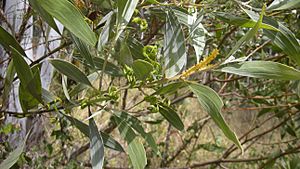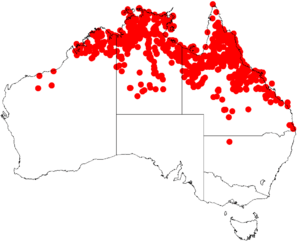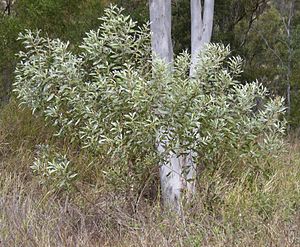Strap wattle facts for kids
Quick facts for kids Strap wattle |
|
|---|---|
 |
|
| Scientific classification | |
| Genus: |
Acacia
|
| Species: |
holosericea
|
 |
|
| Occurrence data from AVH | |
The Strap Wattle (Acacia holosericea) is a cool shrub that grows naturally in the warm, tropical parts of northern Australia. You might also hear it called soapbush wattle or silver wattle because of its unique look. It's a type of wattle plant, which are well-known Australian trees and shrubs.
Contents
What is the Strap Wattle?
The Strap Wattle is a shrub that spreads out as it grows. It can reach about 3 meters (10 feet) tall and 4 meters (13 feet) wide. Its leaves are actually not true leaves, but flattened leaf stems called phyllodes. These phyllodes are large and grey-green. They are shaped like a spearhead, about 10 to 25 centimeters (4 to 10 inches) long. They feel soft because they are covered with tiny white, silky hairs. You can also see three or four clear veins running through them.
When it flowers, the Strap Wattle produces bright yellow, rod-shaped flowers. These flowers are usually 3 to 5 centimeters (1 to 2 inches) long. After the flowers, thin seed pods form. These pods are twisted and curled, about 3 to 5 centimeters (1 to 2 inches) long. Inside, you'll find shiny dark brown seeds. These seeds are shaped like small oval beans and are 3 to 5 millimeters long. Each seed has a bright yellow part called an aril, and the seeds are safe to eat!
Where Does the Strap Wattle Grow?
This shrub is found in the northern parts of Australia. It grows in Western Australia, the Northern Territory, and Queensland. Most of the Strap Wattle plants are found from near Derby in Western Australia. They spread east through the Top End of the Northern Territory. You can find them as far as Rockhampton in eastern Queensland.
Smaller groups of these plants also grow in drier areas. These include the Pilbara region and the Hamersley Range in Western Australia. They are also found in central parts of the Northern Territory and southwestern Queensland. The Strap Wattle often grows near water, especially in sandy or loamy soils. It likes areas where water flows only for a short time, like after rain.
Growing Your Own Strap Wattle
You can grow Strap Wattle from its seeds. However, the seeds need a special treatment before planting. This process is called scarification. It helps the hard seed coat break open so the seed can sprout.
This plant grows quickly and easily. It prefers a sunny spot with soil that drains well. It can grow in most types of soil. The Strap Wattle makes a great feature plant in a garden. You can also use it to create a natural hedge or screen. Its attractive leaves and interesting seed pods make it a beautiful addition to tropical gardens.
Amazing Uses of the Strap Wattle
The seeds of the Strap Wattle are known to be edible. Indigenous Australians have traditionally used parts of this plant for various purposes, including some related to fishing.
See also
 In Spanish: Acacia holosericea para niños
In Spanish: Acacia holosericea para niños


